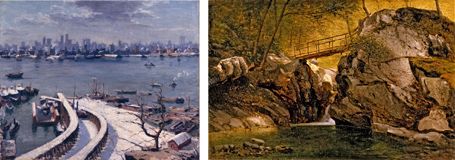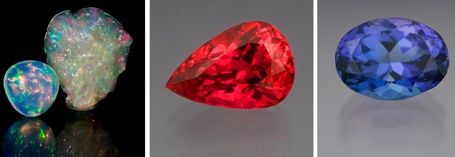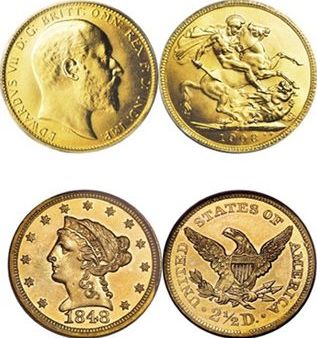 |


Feature Archive
| Collecting For Passion Or Investment |
| |
Building A Long Term Collecting Strategy
|
| By Laurence C. Zale |
|
|
The urge to collect has revealed itself throughout history as a fundamentally human phenomenon
- Douglas Cooper, Great Private Collections, Weidenfeld and Nicolson, London, 1963. |
FOR LOVE, OR MONEY, OR BOTH
Why do people collect? Many have asked themselves, & there is no easy answer. 20th Century British art historian, author & broadcaster Kenneth Clark —the grand art historical explainer—thought it was analogous to asking why people fall in love: they are various and irrational. Yet collectors & inheritors (their overlooked counterparts) are driven by motives ranging from curiosity and passion to financial gain & tax relief. While many feel an emotional involvement with their collections some view them as disposable assets akin to stocks, bonds, & real estate.
Historically, collectors have pursued objects such as fine art, jewelry and gems, collectibles, antiques and other personal property with a dedication and discernment rivaling that of an artist in the throes of creation. Others have collected objects as a commodity to be arbitraged and flipped by committing capital to investment vehicles such as art funds or private equity funds. Their fund managers are expected to forecast that their portfolio of illiquid assets will have a greater value tomorrow than it does today. One economist referred to this business model as a "floating crap game." Caveat Investor.
Nevertheless, collectors establish their authenticity by possessing objects of desire. Similarly, artists attain their originality by the act of creation. Both choices are intimate expressions of the self. Thus, the sum of the objects—collected or created—exceeds the sum of the parts.
THE COLLECTION
This article will assist new and experienced collectors alike in building and managing a collection with confidence. It explains what to look for in an object, how to document objects, how to care for a collection, and how to initiate an estate planning program for a collection. These tasks are a prerequisite to devising a successful long term collecting strategy. Additionally, a good collector must understand the uncertain outcome of his or her collection just as an artist acknowledges the unknown result of his or her creation. The collector is on a voyage of discovery, often encountering the less attractive attributes of collecting (envy, frustration and despair) while also experiencing the desirable ones (joy, triumph and rarefied bliss).
WHAT TO LOOK FOR IN AN OBJECT
How can the difference between two seemingly identical objects be determined by a collector who is examining them? Collectors can make an informed decision about an object’s value—apart from its aesthetic merit—by using the following criteria: authenticity, provenance, quality, condition and rarity.
Authenticity Is the object genuine? Was it created by the hands of the artist?
Provenance A record of ownership of the object. A complete provenance will track an object from its creation to the present.
Quality An elusive criterion which brings in subjective opinion (often from experts) which helps determine an object’s value.
Condition The condition of an object−−even one of otherwise fine quality−−will reveal its ultimate value. This is especially true for collectibles.
Rarity A rare object is usually valuable, but if that object lies outside a collecting area it may affect the amount.
Other criteria to consider in an object include: culture, subject matter, historical importance, size, and medium.
DOCUMENTING OBJECTS
After acquiring objects collectors must take care of them. They will need to catalogue objects, display some of them and store others. Furthermore, they should make arrangements for appropriate insurance and create a flexible tax, trust & estate plan.
A checklist of information to be researched and tracked when cataloguing objects in a collection includes:
- Artist/Maker and Dates
- Object Type
- Title of Work
- Description of Object
- Date of Work
- Materials
- Dimensions
- Signature
- Condition
- Cost and Date
CARING FOR AND PROTECTING A COLLECTION
The care of a collection includes the following:
- Handle all objects with utmost care
- Avoid placing objects in direct sunlight or strong artificial light
- Store objects in areas that do not attract water or moisture
- Have insurance to protect the value of objects and to provide for their conservation
- Have home security
- Have environmentally controlled storage
ESTATE PLANNING FOR A COLLECTION
Collections of fine art, jewelry and gems, collectibles and other personal property are unique among assets. Their unlimited variety, the way they’re collected, and the vital role they often plays in the lives of collectors will be enhanced by the combined expertise of an independent visual arts advisor, a financial advisor and legal counsel. Together, this triangular constituency can advise collectors large and small on how to use their collections for personal or philanthropic purposes during their lifetime and as part of their estate.
CASE STUDIES
To assist those who are navigating the "exploration of self" known as collecting, I have selected three case studies with selected images from each. These stories are signposts for collectors, whose collections are never complete. Collectors are in a constant state of flux—whether they are buying, managing, selling or donating an object or a collection. Still, they are subject always to the life forces of dollars, division, divorce and death.
 Left: Max Kuehne, (1880-1968) Lower Manhattan, 1913, Oil on panel, 24x30." Right: JF Kensett, Bash Bish Falls, Oil on panel, 12x18.5." Images reproduced with permission of the OSilas Gallery at Concordia College (www.osilasgallery.org)
Left: Max Kuehne, (1880-1968) Lower Manhattan, 1913, Oil on panel, 24x30." Right: JF Kensett, Bash Bish Falls, Oil on panel, 12x18.5." Images reproduced with permission of the OSilas Gallery at Concordia College (www.osilasgallery.org)
Case Study #1: An Art Collector
Abstract: From an early age, the collector loved to draw. As he matured, he was encouraged by local artists to visit a famous art club and attend its auctions. There, these artists donated their works for sale to increase the club’s endowment.
Challenge: Since the collector was neither an art historian, a curator nor a dealer, he had to educate himself "by trial and error" as to how auctions operate. When he gained confidence he bought paintings and watercolors by the local artists, though they were generally under-appreciated by critics, curators and collectors.
Approach: By concentrating, for over 40 years, mostly on paintings from the Hudson River School and the American Impressionists (19th and early 20th century), the collector built a first-rate collection of approximately 400 paintings, which continues to grow.
Value Created: The collector has written a book on the works in his collection and the stories behind them. He exhibits parts of his collection at educational organizations and is a frequent speaker on the joys of building and expanding a collection.
 Left: Natural opal from Lluvisnando, Mexico, 22.47 cts, 18.97 x 18.30 x 11.97mm,inventory #16346 & free-form is 31.66cts. polished in Idar-Oberstein in 1975. Photo courtesy Wimon Manorotkul/www.palagems.com. Center: Natural spinel from Tanzania, 3.60 cts., 11.47 cts. x 7.73 x 6.15mm, inventory #13902. Right: Heated tanzanite, 3.43 cts., 10.32 x 7.68 x 6.00mm, inventory #16816. Photos courtesy Mia Dixon/www.palagems.com
Left: Natural opal from Lluvisnando, Mexico, 22.47 cts, 18.97 x 18.30 x 11.97mm,inventory #16346 & free-form is 31.66cts. polished in Idar-Oberstein in 1975. Photo courtesy Wimon Manorotkul/www.palagems.com. Center: Natural spinel from Tanzania, 3.60 cts., 11.47 cts. x 7.73 x 6.15mm, inventory #13902. Right: Heated tanzanite, 3.43 cts., 10.32 x 7.68 x 6.00mm, inventory #16816. Photos courtesy Mia Dixon/www.palagems.com
Case Study #2: A Gem & Mineral Collector
Abstract: The collector bought gems from the Internet and TV, often acquiring dozens at a time. After paying five figures each for three specific stones he began to question his method since he had no formal training in gems and gemology.
Challenge: The collector had to determine what he wanted, make sure these stones were authentic, and still pursue his love of loose stones not made into jewelry.
Approach: The collector turned to a firm specializing in gems and minerals for advice. It was a good decision. The firm determined that one of the stones he had purchased was beryllium-treated to enhance its color. Another stone was overpriced, which he sought to return. Most importantly, they offered him expert advice on which gems he should purchase within his budget.
Value Created: The collection currently has many quality individual stones and is worth seven figures. Many of the stones are on display at various institutions throughout the nation.
 Top: Obverse and reverse of 1908 Canadian Sovereign, Ottawa Mint.
Top: Obverse and reverse of 1908 Canadian Sovereign, Ottawa Mint.
Bottom: Obverse and reverse of 1848 Proof Quarter Eagle.
Photos courtesy Heritage Auction Galleries (www.ha.com)
Case Study #3: A Coin Collector
Abstract: The collector was a working "everyman," an ordinary man by his own admission. He was however, intrigued by history and far-away places, and amassed one of the most famous and valuable numismatic collections in America.
Challenge: He was a middle manager at a large corporation who had limited disposable income to purchase coins, but was blessed with a "wonderful memory."
Approach: By thinking like a collector first, he bought only coins in extraordinary condition that were rare, and relied on his memory to compensate for his lack of formal training and experience.
Value Created: A man of modest means, with a sizeable memory and the discipline to collect only coins of the highest quality and rarity created one of the great private collections. After his death in the 1990’s, the collection was sold for over $30 million.
THE TAKE AWAY
Collecting is meaningful because its rejects closure and continuously opens itself to the world in which we live: our culture, its unpredictability and its increasing complexity. A phenomenon Kenneth Clark described as "that complex human relationship which gives the private collection its life."
(This article was originally published in the Chubb Collectors Newsletter.)
| Art collector Laurence C. Zale is president of Laurence C. Zale Associates, an independent NY visual arts advisory firm for collectors, public charitable organizations, private foundations and corporations. His company’s services include strategic planning that results in the acquisition, ownership or disposition of artworks and other tangible personal property. He is a trustee and chairman of the real estate committee at the Brookdale University Hospital and Medical Center, Brooklyn, NY, and a member of the American Association of Museums and the Association of Healthcare Philanthropy. He is a frequent speaker and writer on the use of visual arts for personal or philanthropic purposes and has taught at the Sotheby’s Art Business program in New York. He was educated at Washington University in St. Louis; NYU; and the Courtauld Institute of Art, University of London, London, England. Contact lczale@visualartsadvisory.com or visit www.visualartsadvisory.com. |
|
|
Past Articles
2009
Venetian Rivals: Titian, Tintoretto, Veronese, by Joseph Phelan
Fritz Scholder: Indian/Not Indian, by K. Kimberly King
2008
"The Primacy of Color", by K. Kimberly King
Fame and the Founding Father, by Joseph Phelan
"There is no final photograph", by K. Kimberly King
2007
How Edward Hopper Saw the Light, by Joseph Phelan
Giving "New Worlds to the World": Portugal and the World in the 16th and 17th Centuries, by K. Kimberly King
London Views: Spring 2007 and Beyond, by Diane Apostolos-Cappadona
Modernism: Designing a New World, 1914-1939, by K. Kimberly King
Italian Women Artists from Renaissance to Baroque, by Diane Apostolos-Cappadona
What Jasper Johns "Can't Avoid Saying", by K. Kimberly King
Holy Image/Hallowed Ground: Icons from Sinai, by Diane Apostolos-Cappadona
2006
Prayers and Portraits: Unfolding the Netherlandish Diptych, by Diane Apostolos-Cappadona
Stop, See, and Soar:
"Société Anonyme", by K. Kimberly King
Constable's Great Landscapes, by Joseph Phelan
Editorial: Save Studio 60 (from needing to be saved), by John Malyon
Far From Heaven: Anselm Kiefer at the Hirshorn, by Joseph Phelan
Henri Rousseau: Self-Taught in Paris, by K. Kimberly King
Klee, Hitler and America, by Joseph Phelan
Anyone For Venice?, by Joseph Phelan
The Legends of Leonardo, by Joseph Phelan
Hey, "Dada"-Dude, Where's the Rest of Me?, by K. Kimberly King
Cézanne in Provence, by Joseph Phelan
Angels in America: Fra Angelico in New York, by Joseph Phelan
2005
Notes on New York (NoNY), by Joseph Phelan
The Greatest Painting in Britain
French Drawings and Their Passionate Collectors, by Joseph Phelan
Missing the Picture: Desperate Housewives Do Art History, by Joseph Phelan
The Salvador Dalí Show, by Joseph Phelan
2004
Boston Marathon, by Joseph Phelan
Philadelphia is for Art Lovers, by Joseph Phelan
Featured on the Web: Understanding Islamic Art and its Influence, by Joseph Phelan
Independence Day: Sanford R. Gifford and the Hudson River School, by Joseph Phelan
The "Look" of Mel Gibson's The Passion of the Christ, by Joseph Phelan
The Importance of Being Odd: Nerdrum's Challenge to Modernism, by Paul A. Cantor
2003
Advent Calendar 2003, narrated by Joseph Phelan
If Paintings Could Talk: Paul Johnson's Art: A New History, by Joseph Phelan
Mad Max [Max Beckmann], by Joseph Phelan
Marsden Hartley: The Return of the Native, by Joseph Phelan
Jean-Antoine Houdon: Sculptor of the Enlightenment, by Joseph Phelan
Frederic Remington's Nocturnes, by Joseph Phelan
Magnificenza! Titian and Michelangelo, Manet and Velazquez, by Joseph Phelan
Masterful Leonardo and Graphic Dürer, by Joseph Phelan
Favorite Online Art Museum Features, by Joseph Phelan
Studies for Masterpieces, by John Malyon
2002
Portrait of the Artist as a Serial Killer, by Joseph Phelan
Renoir's Travelling, Bonnard's "At Home, by Joseph Phelan
The Philosopher as Hero: Raphael's The School of Athens, by Joseph Phelan
The Greatest Works of Art of Western Civilization
Celebrating Heroes; Celebrating Benjamin West, by Joseph Phelan
Chasing the Red Deer into the American Sublime (Education and the Art Museum, Part II), by Joseph Phelan
Planning Your Summer Vacation, by Joseph Phelan
Education and the Art Museum, Part I, by Joseph Phelan
Unsung Griots of American Painting, by Joseph Phelan
The British Museum COMPASS Project, interview by Joseph Phelan
Robert Hughes, Time Magazine Art Critic: Biography and Writings
2001
Software review: Le Louvre: The Virtual Visit on DVD-ROM, by Joseph Phelan
Tragedy and Triumph at Arles: Van Gogh and Gauguin, by Joseph Phelan
Her Last Bow: Sister Wendy in America, by Joseph Phelan
Love, Death and Resurrection: The Paintings of Stanley Spencer, by Joseph Phelan
Who is Rodin's Thinker?, by Joseph Phelan
Celebrations North and South, by Joseph Phelan
Rubens and his Age, by Joseph Phelan
Great Reproductions of Great Paintings
The Passion of Christ, by Joseph Phelan
Edouard Manet: Public Spaces, Private Dreams, by Joseph Phelan
Henry Moore and the British Museum: The Great Conversation, by Joseph Phelan
2000
Notorious Portraits, Part II, by John Malyon
Notorious Portraits, Part I, by John Malyon
The Other Michelangelo, by Joseph Phelan
The Art of Drawing, by Joseph Phelan
Poussin and the Heroic Landscape, by Joseph Phelan
Great Art Museums Online, by Joseph Phelan
Venetian Painting and the Rise of Landscape, by Joseph Phelan
Forbidden Visions: Mythology in Art, by Joseph Phelan
Themes in Art: The Passion of Christ, by Joseph Phelan
Web site review: Christus Rex
Web site review: National Gallery of Art, Washington, D.C., by Joseph Phelan
Online exhibit review: Inuit Art: The World Around Me, by John Malyon
Poll: Who is Producing the Most Interesting Art Today? (Results)
Poll: Who is Producing the Most Interesting Art Today? (Part II)
1999
Poll: Who is Producing the Most Interesting Art Today? (Part I)
Spotlight on The Louvre Museum
Spotlight on Impressionism
Spotlight on Optical Art
Spotlight on Animals in Art
Spotlight on Surrealism
Spotlight on Sculpture
Spotlight on Women in the Arts
Spotlight on The Golden Age of Illustration
Spotlight on Vincent van Gogh
Spotlight on Great Art
|


